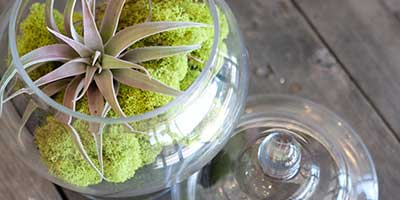Sometimes, there’s nothing like fresh herbs to top off that meal you’re working hard on. We here at KaBloom know that sometimes it can be hard to find the best product at a moment’s notice, so that’s why we strive to provide our customers with the freshest plants possible. Check out these tips for growing your own indoor herb garden, and soon you’ll be able to put the freshest herbs into your recipes!
Proper placement in your house is probably the most important part of starting the process. Plants obviously need a lot of sun, so a location near a window or somewhere that gets a good amount of natural light is best. At least four hours is the recommended amount of sunlight to make sure you get delicious results! But, if you start seeing brown spots on the leaves, that’s a sign that the plant might be getting too much sunlight.
As for temperature, herbs are kind of like people! When we think the temperature is comfortable, they will, too. It’s best to keep them between 65 and 75 degrees. Just make sure that you don’t keep them near something that can dry it out, like a heating or air conditioning system. Also, once they start growing, make sure the leaves don’t touch the windowpane if they’re growing near the window, for this could cause the leaves to die.
When you’re planting the seeds, make sure you use a premium potting mix to help the plants thrive. As with any plant, water is important. But, too much water can be very harmful to the plant, and its roots could potentially rot. So, don’t over water, but also make sure that you grow the herbs in metal, plastic, or rubber pots. Clay pots work well and help with drainage, but sometimes it makes the plant dry out quickly depending on the weather conditions. One of our favorite ways to grow herbs is in window planters, which you can purchase at nurseries or garden care stores. These planters allow you to grow multiple herbs in one unit, which also helps with space, and also can act as a nice addition to your kitchen’s décor. If you do choose this way, try mixing and matching herbs in one container, so it also helps add a variety to your kitchen! Whatever you use, make sure you have a tray or something under the pots to catch any draining water! As you get to know your plants, you’ll learn how to tell when they need water, so learn its schedule and follow what it asks for.
Once the herbs begin to grow, fertilize them monthly with an organic fertilizer to make sure that it stays healthy. If you see the plants are growing longer but have fewer leaves, that’s a sign that the plant is looking for more sunlight, so move it closer to a source of natural light. Because they’re growing indoors, the herb plants will possibly grow quicker, so you’re be able to have a lot of fresh leaves even more often!
With these simple steps, you’ll be able to have fresh herbs at your disposal for your cooking needs. Before you start, though, look into the different kinds of herbs you can grow, because some are easier to grow than others. So, depending on your green thumb, it might be easier to start off by trying to grow, say, parsley before you move onto basil. Stay tuned for more updates!












